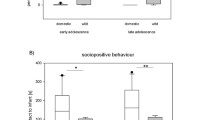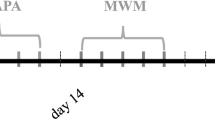Abstract
The oft-repeated concern for the lack of behavioral comparability of domestic rats with wild forms ofRattus norvegicus is unfounded. Laboratory rats appear to show the potential for all wild-type behaviors, including the most dramatic social postures. Moreover, domestics are capable of assuming a feral existence without difficulty, one where they readily behave in a fashion indistinguishable from wild rats. The one behavioral difference that is clearly established concerns performance in laboratory learning paradigms. The superiority of domestics in these laboratory tasks speaks more to quieting the concerns of degeneracy theorists than to problems of using domestic Norway rats as subjects representative of their species.
Similar content being viewed by others
References
Bamber, R. T., and Boice, R. (1972). The labyrinth method of comparing wild and domestic rats.Psychonom. Sci.,29:161–163.
Barnett, S. A. (1963).The Rat, Aldine, Chicago.
Boice, R. (1966). The problem of domestication in the laboratory rat, Unpublished dissertation, Michigan State University, East Lansing.
Boice, R. (1968). Conditioned licking in wild and domestic Norway rats.J. Comp. Physiol. Psychol. 66: 696–799.
Boice, R. (1970). Effect of domestication on avoidance learning in Norway rats.Psychonom. Sci. 18:13–14.
Boice, R. (1971a). Excessive water intake in captive Norway rats with scarmarkings.Physiol. Behav. 7:723–725.
Boice, R. (1971b). Laboratorizing the wild rat (Rattus norvegicus).Behav. Res. Meth. Instru. 3:177–182.
Boice, R. (1972). Some behavioral tests of domestication in Norway rats.Behaviour 42:198–221.
Boice, R. (1973). Domestication.Psychol. Bull. 80:215–230.
Boice, R. (1977). Burrows of wild and domestic rats: Effects of domestication, outdoor raising, age, experience, and maternal state.J. Comp. Physiol. Psychol. 91:649–661.
Boice, R. (1981a). Captivity and feralization.Psychol. Bull. 89:407–421.
Boice, R. (1981b).Ethological Psychology, Brooks/Cole, Monterey (in press).
Boice, R., Denny, M. R., and Evans, T. A. (1967). A comparison of albino and wild rats in shuttlebox avoidance.Psychonom. Sci. 8:271–272.
Boice, R., Hughes, C. W., and Bamber, R. T. (1976). Learning comparisons of wild and domestic Norway rats. Unpublished paper.
Clark, M., and Galef, B. G. (1980). Effects of rearing environment on adrenal weights, sexual development, and behavior in Gerbils: An examination of Richter's domestication hypothesis.J. Comp. Physiol. Psychol. 94:857–863.
Connor, J. L. (1972). Genetic mechanisms responsible for the domestication of the laboratory mouse. Paper presented at the meeting of the Behavior Genetics Association.
Daly, M. (1973). Early stimulation of rodents: A critical review of present interpretation.Br. J. Psychol. 64:435–460.
Darwin, C. (1958).Origin of Species, John Murray, London.
Darwin, C. (1868).The Variation of Plants and Animals Under Domestication, John Murray, London.
Epstein, H. (1971).The Origins of the Domestic Animals of Africa, Vol. I, Africana, New York.
Hale, E. B. (1969). Domestication and the evolution of behavior. In Hafez, E. S. E. (ed.),The Behavior of Domestic Animals, 2nd ed., Balliere, Tindall and Cassell, London.
Hughes, C. W. (1975). Early experience in domestication.J. Comp. Physiol. Psychol. 88:407–417.
Hughes, C. W., and Boice, R. (1973). Domestication, sophistication, and avoidance in norway rats.J. Comp. Physiol. Psychol. 84:408–413.
Hughes, C. W., Settle, A. V., and Boice, R. (1976). Four indices of domestication in Norway rats.Bull. Psychonom. Soc. 8:171–174.
Kavanau, J. L. (1964). Behavior: Confinement, adaptation, and compulsory regimes in laboratory studies.Science 143:490.
King, H. D. (1939). Life processes in gray Norway rats during fourteen years in captivity.Am. Anat. Mem. 17:1–72.
Lockard, R. B. (1968). The albino rat: A defensible choice or a bad habit?Am. Psychol. 23:734–742.
Logan, F. A., and Boice, R. (1969). Aggressive behaviors of paired rodents in an avoidance context.Behaviour 34:161–183.
Lorenz, K. (1940). Durch Domestikation verursachte Storungen arteigenen Verhaltens.Z. Psychol. Charakt. 59:2–82.
Millar, R. D. (1975). Free-operant comparisons of wild and domestic Norway rats.J. Comp. Physiol. Psychol. 89:913–922.
Miller, D. B. (1977). Social displays of Mallard Ducks (Anas platyrhynchos): Effects of domestication.J. Comp. Physiol. Psychol. 91:221–232.
Price, E. O. (1976). The laboratory animal and its environment. In McSheeny, T. (ed.),Control of the Animal House Environment, Laboratory Animals, London.
Price, E. O., and King, J. A. (1968). Domestication and adaptation. In Hafez, E. S. E. (ed.),Adaptation of Domestic Animals, Lea & Febiger, Philadelphia.
Ratner, S. C., and Boice, R. (1975). Effects of domestication on behavior. In Hafez, E. S. E. (ed.),Behaviour of Domestic Animals, 3rd ed., Williams & Wilkins, Baltimore.
Richter, C. P. (1954). The effects of domestication and selection on the behavior of the Norway rat.J. Natl. Cancer Inst. 15:727–738.
Richter, C. P. (1959). Rats, man and the welfare state.Am. Psychol. 14:18–28.
Richter, C. P., and Mosier, H. D. (1954). Maximum sodium chloride intake and thirst in domesticated and wild Norway rats.Am. J. Physiol. 176:213–222.
Robinson, R. (1965).Genetics of the Norway Rat, Pergamon, Oxford.
Skinner, B. F. (1966). The phylogeny and ontogeny of behavior.Science 153:1205–1213.
Stone, C. P. (1932). Wildness and savageness in rats of different strains. In Lashley, K. S. (ed.),Studies in the Dynamics of Behavior, University of Chicago Press, Chicago.
Thiessen, D. D. (1966). The relation of social position and wounding to exploratory behavior and organ weights in house mice.J. Mammal. 47:28–34.
Tinbergen, N. (1965).Animal Behavior, Time-Life, New York.
Ulrich, R. (1966). Pain as a cause of aggression.Am. Zool. 6:643–662.
Yerkes, R. M. (1913). The heredity of savageness and wildness in rats.J. Anim. Behav. 3:286–296.
Author information
Authors and Affiliations
Rights and permissions
About this article
Cite this article
Boice, R. Behavioral comparability of wild and domesticated rats. Behav Genet 11, 545–553 (1981). https://doi.org/10.1007/BF01070009
Received:
Accepted:
Issue Date:
DOI: https://doi.org/10.1007/BF01070009




